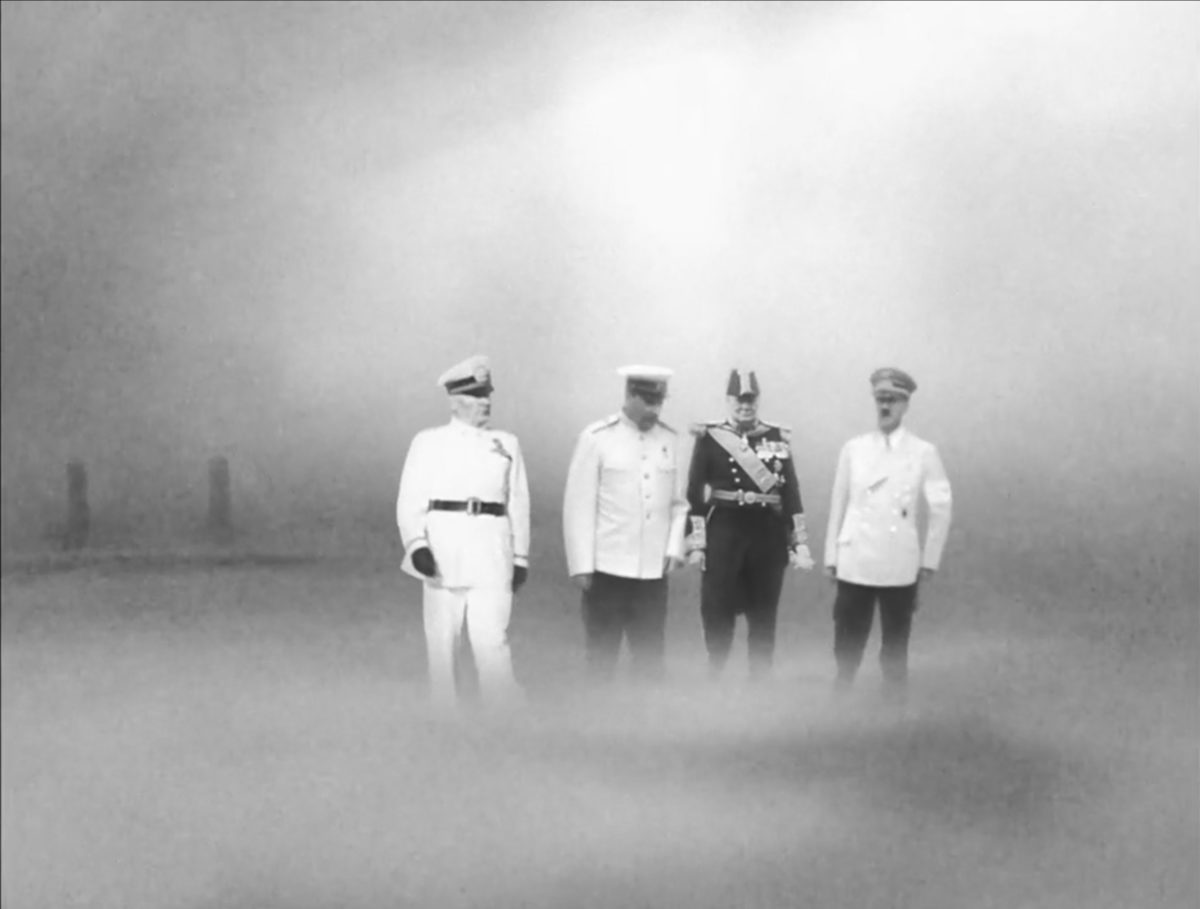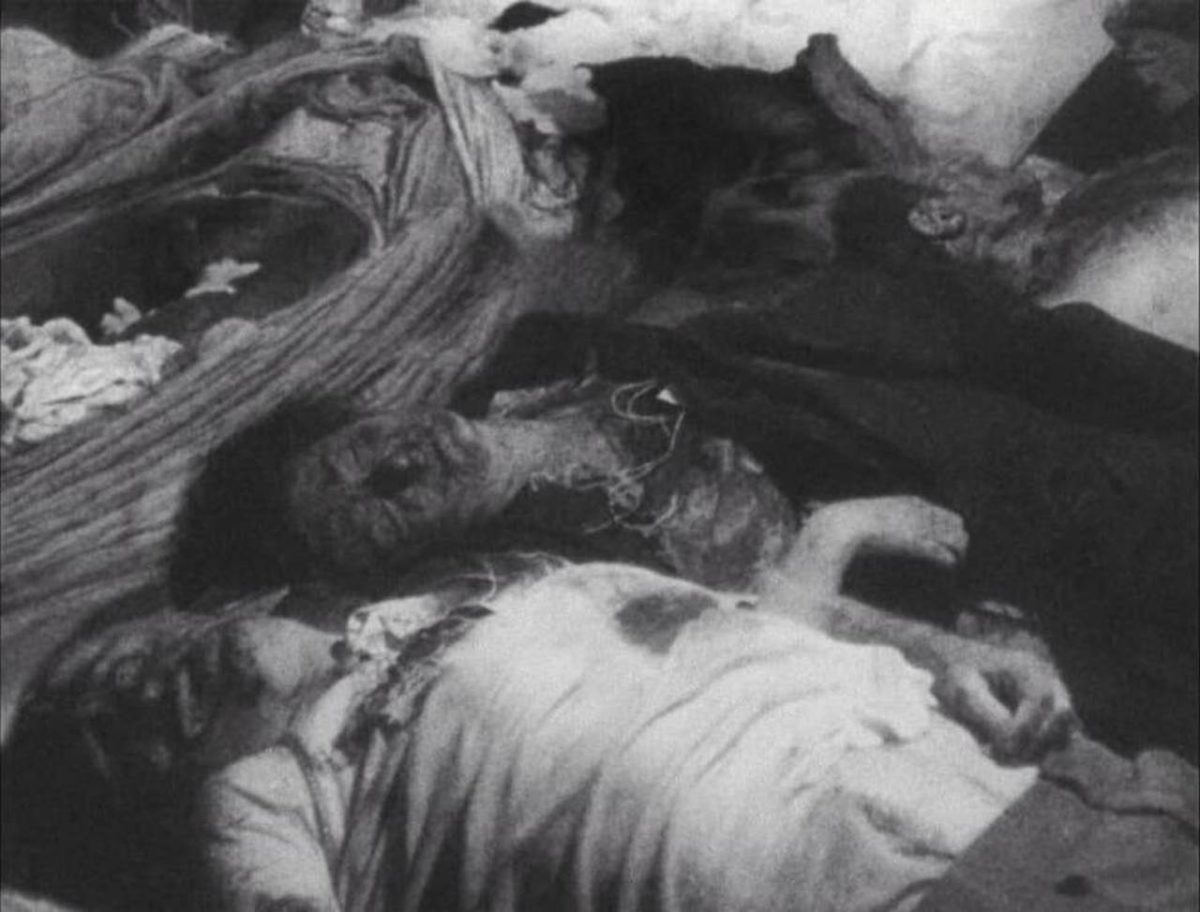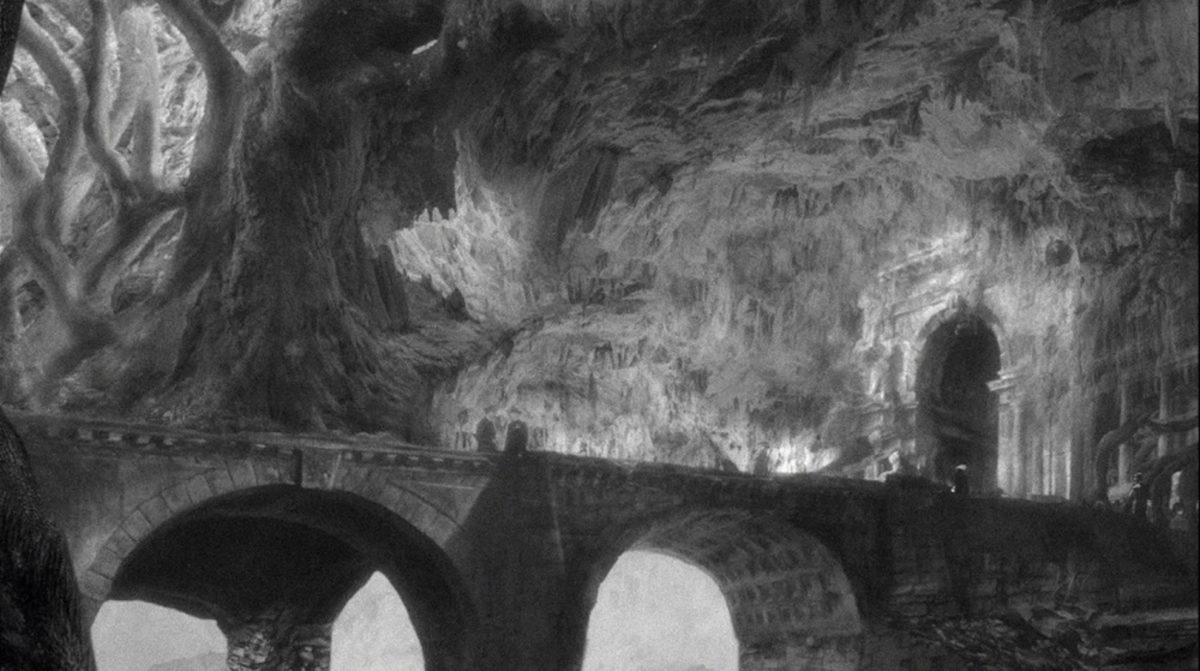In Aleksandr Sokurov’s Fairytale, restless spectres haunt a landscape somewhere between Gustav Doré’s illustrations of the Divine Comedy and Giambattista Piranesi’s depictions of an abandoned monumental Rome. Their names are Stalin, Hitler, Mussolini, Churchill and they all wander around what looks to be Purgatory, waiting for Heaven’s door to open. This imaginary place forms the backdrop to a series of jokes, squabbles and futile remarks. Among the privileges that Sokurov, a historian by training, has claimed for himself for years is the familiarity with which he usually treats these great personalities. The Russian director wanders through history as if he were at home, thus without too much formality. His vertiginous face-to-face dialogue with the greats of history finds in Fairytale its last chapter. What distinguishes the film from the director’s previous works—and, one might say, from every other film, so unique does it seem to be in form and content—is its singular use of old archival images. Cut from the original footage, the bodies and faces of Stalin, Hitler, Mussolini and Churchill are integrated into a foggy digital landscape and dubbed by actors in their respective languages. This operation appears to be the fulfilment of an old obsession of Sokurov’s, that with ghosts, more specifically, the old ghosts of history, like the ones populating the Hermitage and the Louvre in Russian Ark (2002) and Francofonia (2015), respectively. In those films, the Museum replaces what Purgatory is in Fairytale: a place where the past continues to exist, despite everything.
This fascination with the past, with a world that precedes us and of which we know almost nothing, a world that remains an enigma to us (to be questioned and which in turn questions us), is a recurring theme in Sokurov’s work. In Francofonia, Sokurov confesses to being enraptured by the faces depicted in the Louvre paintings, the faces of the people. “Who would I have been,” he asks himself, “if I had not been able to see the eyes of those who lived before me?” In the film, however, there are not only paintings, but also photographs and archival footage, even more exact in rendering the faces; those of the people, once again, in caps and tattered clothes or in sailor uniforms, but also those of Chekhov and Tolstoy, mute and “asleep”. Yet all this is not enough for Sokurov, who is interested in what is hidden behind these images, in what these images neither say nor show. So, to real archival footage will be added other, fake footage, shot by Sokurov and then treated to simulate the imperfections of celluloid to make it seem real; or real images of Hitler wandering around Paris will be supplied with a fake dubbing in which the German dictator expresses his interest and admiration for the Louvre (here we can already see a kind of anticipation of Fairytale). Russian Ark presents the reconstruction of different periods of Russian history in one long take, which makes it possible to realistically render the first-person experience of a fortuitous witness of these moments in the past. Like the proverbial fly on the wall, we thus find ourselves chasing Catherine II or attending a grand ball. Sokurov tries to communicate in these films the feeling of an absence with regard to the past and its images (to which we feel called and from which we at the same time feel cut off) that only cinema can hope to transform into a presence.
Clarifications must be made on this issue, however. In Russian Ark, Sokurov exploits cinema’s exactness in capturing the moment, but, for obvious reasons, he cannot show the real thing he would like to show but is forced to simulate reality. In other words, the “phantom effect” sought by the film, which would rely on cinema’s ability to capture reality (and reproduce it immutably), is simulated rather than real, as the film is only able to capture the “ghosts” of the actors playing the various historical characters and not the real characters, whose only visual reference we have is moreover pictorial, hence second-hand (with the sole exception of the family of Nicholas II, of whom we have photographs and footage). The same can be said for Francofonia, which is more interested in the history of the 20th century and in particular the Nazi occupation of France, with the difference that here an ulterior “effect of realness” is added by the simulation of the dust and scratches of the film in some scenes involving the then director of the Louvre Jacques Jaujaurd and Count Wolff-Metternich (played by actors), without, however, concealing the fictitious nature of this “historical forgery” (at the beginning of one scene, a crew member is seen tapping the clapperboard, while Sokurov’s voice-over warns that what we are about to see is a reconstruction: “If we imagined what happened, could this be it?”). This demonstrates the impossibility, of which Sokurov seems to be well aware, of returning to the past as if it were present, the impossibility, that is, of dispensing with our partial perspective, so that our knowledge of the past can only be mediated.

Specifically, film and photography are the visual referents of 20th century history in the same way that painting is of pre-20th century history, points of access to an otherwise inaccessible experience. What Sokurov considers essential in his artistic practice is to fill the empty spaces left in between these testimonies, relying on the voyeuristic impulse inherent in the film medium: the desire to see the unseen. This is where Fairytale comes in: here Sokurov is no longer forced to settle for actors replacing real historical characters, but can finally direct real historical characters like actors. What we see on the screen are the real “ghosts” of Churchill, Hitler, Mussolini and Stalin, reproduced in philological black and white, thus avoiding colouring archive images to achieve a result closer to reality (as done, for example, by Peter Jackson in They Shall Not Grow Old, 2018), since Sokurov’s realism seems to have as its objective not so much to show the past as it must have seemed to those who lived it, but rather to show it as it must appear to those who have never lived it. One can immediately see, though, how the realism that the archive images seem to lend to the film soon dissipates into the unrealism of the context, and how, starting from the immanence of these images, Sokurov proceeds instead to illustrate a metaphysical landscape.
Sokurov has been mostly secretive and vague about the technical process of the movie—“the technological procedure of the film remains the professional secret of our team,” he said sardonically at the press conference in Locarno—but many assumed it involved deepfake technology, due to the uncanny similarity of the final result with the hundreds of videos circulating online (to which we have become accustomed in recent years) that use artificial intelligence to lip-sync famous people, or to superimpose their features on the facial movements of actors—mostly with comic intentions, making them say ridiculous things or perhaps sing a catchy song. However, in a recent text written for an Italian movie magazine to present the movie, Sokurov definitely denies the use of deepfake or artificial intelligence tools (as is also made clear by a disclaimer added at the beginning of the version of the film for the Italian distribution): “Throughout this process, I never considered the idea to resort to deepfake […] It was precisely the intention to render as much authenticity as possible that dictated the form of the film, a mosaic of thousands of archive images, the result of meticulous, painstaking and strictly manual work.”Sokurov A., ‘Quel che resta del Novecento [tra le rovine di una fiaba]’, in FilmTv, n. 51, 2022. Sokurov is keen to distance his film from any topical discussion of artificial intelligence, and instead claim its artisanal dimension. The dubbing, though, struggles to integrate into the footage and the movements of the characters’ lips seem at times to be animated and not totally natural, so that the final effect is not far removed from deepfake, going somewhat against Sokurov’s quest for authenticity. Watching these characters—inert and alive at the same time—move their lips like puppets, one really gets the impression of witnessing a gloomy and eerie puppet theatre, somewhere between a fairy tale and Commedia dell’Arte jests. The title chosen by Sokurov suggests a more than fitting interpretation, because what actually distinguishes this Purgatory from a bewitched forest, or the film’s characters from Pinocchio and Geppetto, trapped in the belly of the whale? After all, in fairy tales you have to know the magic words to open the doors.
But, leaving aside the technical process, what differentiates Sokurov’s film from other possible examples of manipulation of celebrities’ features is that it doesn’t stop at a merely iconographic level, where the faces and bodies of famous people play the role, precisely, of icons, of plain signals that are easy to decode and produce an immediate effect on the audience, but inserts these icons into a dramaturgy that, however apparently simple, requires a different kind of participation of the spectator, who is called upon to interpret an ambiguous spectacle. Stalin, waking up amidst the old ruins of European culture, finds himself next to a suffering Jesus Christ, who cannot move from his bed, while the ghost of Napoleon gives Hitler a bomb as a present, which the latter then throws, with slapstick instinct, into a windmill (unexpectedly adding Cervantes to the many references that make up the film’s landscape, some of them admitted by Sokurov himself: the aforementioned Piranesi and Doré, but also Dürer and Hubert Robert). In Russian Ark and Francofonia, films no less dense with references, Sokurov’s voice-over at least allowed the spectator to orientate themselves, and indeed did even more than this, making possible a dialogue (or an illusion of it) with the past, as happens in Russian Ark between the protagonist and the Marquis de Custine or in the final scene of Francofonia, in which Sokurov reveals to his characters their future as they stare into the camera. But if these films operated between the emotion of the beginning (what comes before) and the anguish of the end (what comes after), in Fairytale everything happens to merge ominously into a nightmare out of time (the co-presence of several versions of the various despots reinforces a feeling of temporal implosion), where the past, fixed in a funeral aura, seems lost in a crazy and solipsistic monologue. The film has no real conclusion and ends as it begins, with the characters wandering aimlessly through Purgatory. We do not know whether they will finally manage to pass through the door before which they present themselves in turn, or what exactly is hidden behind that door, nor how much hope there is in the Last Judgement patiently awaited by Jesus.

Its apocalyptic setting without apocalypse also distinguishes Fairytale from Sokurov’s trilogy of power, consisting of Moloch (1999), Taurus (2001) and The Sun (2005), films which nevertheless seems more natural to associate with Fairytale due to their merciless portraits of their protagonists (Hitler, Lenin and Hirohito, respectively): almost reduced to burlesque figures, shown as narcissistic, powerless, childish, they are not men placed on a higher level, but on the contrary rather banal men. Lacking in Fairytale, despite a similar portrayal of its protagonists, is the tragic quality that these films derive from being set at focal moments in the lives of these men, caught on the road to decline. Sokurov prefers instead to push even harder on the side of comedy, having Dante’s comedia as his declared model, with its mixture of high and low; but here this peculiar blend, resulting in the desecration of these leaders, who in the film stink and even have snot, serves to put them back in their proper role in the play of history. While these great talkers are engrossed in their petty and puerile speeches, the corpses of World War II soldiers begin to emerge in the background, acting as a chilling reverse shot to the frivolity of their executioners. The only words these dead utter are words of vengeance. These faces and bodies are the people, the eternal victims of history.
The people, or rather the masses, these great protagonists of the 20th century, return later in what is the film’s most memorable moment, introduced by deafening, overwhelming music as well as the change of the image to an anamorphic format. They are portrayed as a stormy sea, itself composed of other ghosts, distorted archival images: they mostly have no faces, of their bodies we only see their arms stretched upwards, which really seem to have the consistency of ectoplasms. This evocation, concrete and abstract at the same time, of the great parades and mass gatherings that legitimised the power of these tyrants reveals a people no longer seen only as victims, but also as executioners, or at least accomplices of the horrors committed in their name. The choice of depicting the people as a sea is interesting in any case, since the sea is used, both in Russian Ark and in Francofonia, as a metaphor for history. Perhaps the people should therefore be considered an impersonal force as much as history itself, moved not by its own will nor by the will of an individual who rises above it, as the tyrants of the film delude themselves, obnubilated by the ecstasy of power. (In another moment of the film, among other corpses, one can also see the deformed one of Mussolini, next to his lover Clara Petacci, as a reminder that a stormy sea can never be trusted.) The words spoken by Sokurov in Francofonia, evoking Chekhov, seem perfect to describe the scene: “The sea swelled, over each wave another would break, and there was neither sense nor pity in them.” The people too, like the history of which they are the engine and at the same time the victims, advance without sense or pity.
In this discourse on ghosts and the masses (and on the ghosts of the masses), it seems legitimate to evoke another ghost, that of Marx, insofar as his thought calls into question the issue of the spectre, as demonstrated by Jacques Derrida, particularly in his book Specters of Marx. Above all, Marx’s exhortation in The Eighteenth Brumaire of Louis Napoleon to let the dead bury the dead, that is, to banish the ghosts of the past in view of the revolution to come, springs to mind. Precisely this banishment of the ghost represents for Derrida a limitation of Marx’s thought, both because he considers spectrality irreducible and because he recognises in it an important element of the revolutionary movement. Sokurov, albeit from a radically different perspective, would probably oppose Marx’s exhortation like Derrida, as it is clear that he does not believe in the possibility of banishing ghosts either, nor does he seem to wish for it, immersed as he is in his historical reminiscences. In Fairytale, Hitler exhorts Mussolini to move on and not to get caught up in melancholy, not to listen to Sokurov, while Churchill self-criticises himself for lingering melancholically on the memory of his deceased mother. This critique of melancholy (and thus of that meditative and sentimental attitude that is so characteristic of his cinema) which Sokurov puts into the mouths of his characters appears to be a symptom of what he mainly reproaches these men for: their insensitivity to anything outside their ambitions, their egoistic desire to predict, calculate, control the future, to the detriment of everything else, both past and present, like Hitler in Moloch who reasons about the fate of Germany in the centuries to come and hopes one day to dominate death, or like Stalin who, at the end of Fairytale, completely blind to the horrors and suffering of history, reveals to Churchill his own naïve vision of the future: “Bright colours, laughter, the scent of lilacs…” “You don’t see a thing,” Churchill replies, finally asking him if it is true that he did not go to his mother’s funeral. To the pettiness of politics and power dynamics Sokurov seems to oppose the importance of mourning, understood as a moral obligation and proof of humanity, the need to take on the legacy of the dead and their memory if we are to avert what the director makes Churchill say: “Everything will be forgotten and it will start over.” For Sokurov, it is up to the living to bury the dead.
